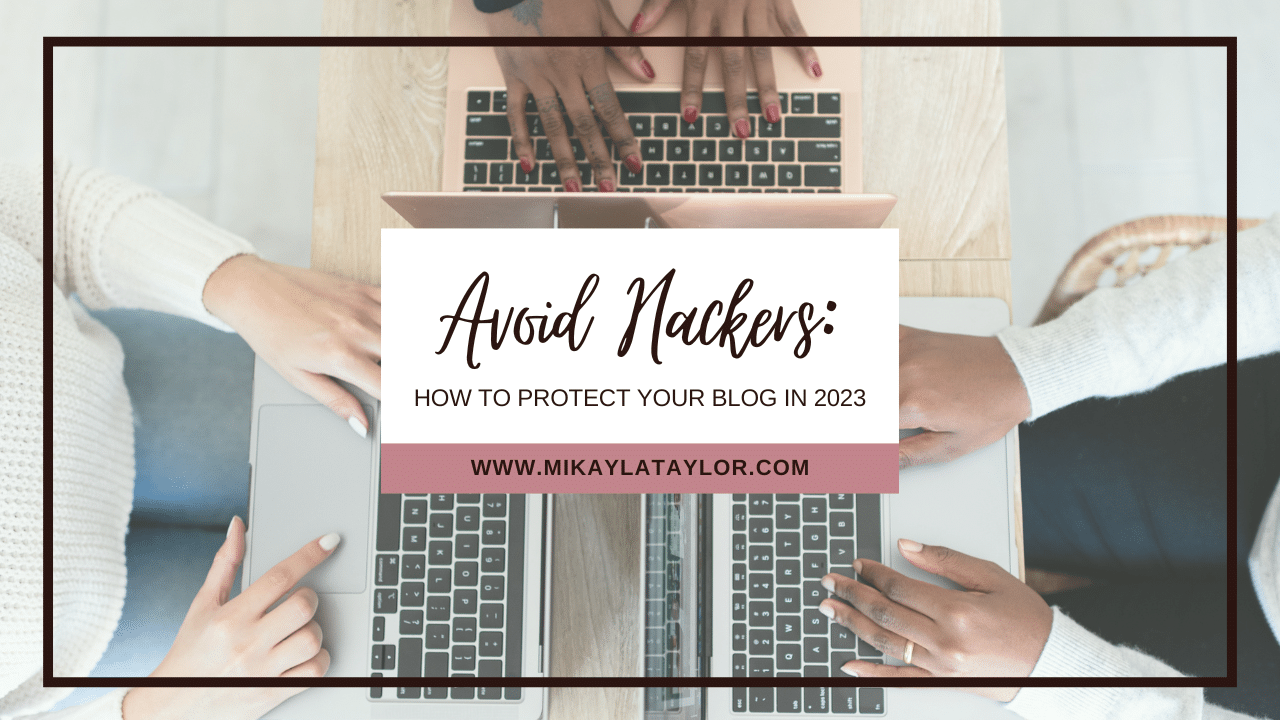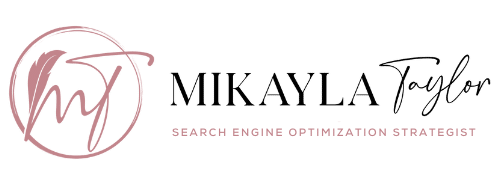
Are you a content creator, influencer, or blogger who wants to know how to protect your blog in 2023? You’re not alone. Keeping your blog secure from hackers is essential in this digital age.
You may have seen on TikTok I shared a few videos about protecting your blog in the new year. I’ve heard of one too many scare stories late last year where women lost years’ worth of blog posts and content due to phishing attempts and hackers.
Talk about a blogger’s worst nightmare! Hackers are always finding new ways to compromise websites to gain information for their own gain or malicious purposes. I’ve heard of blogs being held for ransom!
That’s heartbreaking when you spend years putting in the effort to grow your blog. As a content creator, having an incomplete understanding of cybersecurity could put you at risk of becoming the next victim.
It’s time to get serious about security and learn how to protect your blog from being hacked.
Keep reading this blog post to learn my top WordPress tips and plug-ins to secure your blog.
The Potential Risks of Not Protecting Your Blog
The risks of not protecting your blog are huge and could lead to a complete loss of content if your blog gets into the wrong hands. Failing to protect your blog leaves your hard work as a content creator vulnerable to various risks. Hacking, data breaches, spamming, and other unwanted activities can decrease traffic and therefore decrease revenue to what should be a money-making blog!
WordFence Security is the amazing security plug-in I use (and no, that’s not an affiliate link). Having WordFence installed really gives me peace of mind that my website is protected from the latest hacking scams. I recommend WordFence to all of my clients!
Recently, they published the Wordfence 2022 State of WordPress Security Report, which includes a recap of some of the top security issues for WordPress websites in 2022. They also publish blog posts with the latest hack attacks.
For example, in January, Wordfence published an update about a BitCoin scam, where users receive an email that seemingly comes from their blog or contact form noting that their blog has been hacked and to pay $3,000 bitcoin to recover it. This phishing scam is trying to trick victims into paying money to recover your website.
With Wordfence, you can report these types of emails to the threat intelligence team for investigation. And you can relax knowing that Wordfence has all the latest information on current phishing attacks worldwide to protect your website.
How to Keep Your Blog Secure
In today’s modern world and digital economy, blogs are becoming more popular among content creators wanting to diversify their income streams and follow a non-traditional career path.
I know that’s true for me!
In the modern world, blogs are becoming increasingly popular with content creators and bloggers.
You want to share many things on the internet, but sometimes putting too much personal information out there can put your blog at risk, especially if you don’t take the right safety measures.
The last thing you want is all your blog’s hard work to be ruined due to domain theft or malicious software attacks. Additionally, if you are collecting sensitive information on your blog, such as credit card numbers and email addresses for your audience and subscribers, it is crucial for you to take the necessary steps to secure your website!
- Keep plug-ins up-to-date
One way to keep your blog secure is to regularly update your plug-ins. Just like the apps on your phone need to be regularly updated for bug fixes and malware, so does your website! When new versions of plug-ins become available, be sure that you update them right away! It’s important that your website software stays up-to-date to ensure your blog is protected this year. Plug-in updates often include security patches to protect your website from malicious attacks and cyber threats.
- Regularly back up your content
If you are someone who imagines the worst-case scenario and needs to know how to recover your blog in the event something disastrous happens, you need to regularly back up your content. Updraft Plus (affiliate link) gives me peace of mind in the event of a hack or technical issue. The backup plug-in keeps a copy of all my website’s data in case of any unexpected issues and is stored in a separate cloud server so they won’t be lost even if something happened to all of my accounts (knocking on wood!)
- Use a strong and unique password
A crucial way to protect your blog is to use a strong and unique password for every account associated with your website. You should never use the same password twice! I learned this the hard way when my Afterpay account was hacked while on vacation in Puerto Rico. Someone ordered a bunch of clothes using my information! Thankfully, I use Keeper for password management and can easily change all of my passwords. Definitely check out Keeper if you need help storing and generating strong passwords! If you use the same password for multiple accounts and one account is breached, all your accounts are at risk.
For a strong password, use a mix of uppercase and lowercase letters, numbers, and special characters, and it should be at least 12 characters long. Avoid using easily guessed personal information like your name or birthday in your password.
- Implementing two-factor authentication
Finally, another way to protect your blog is to implement two-factor authentication. This requires a user to provide two forms of identification, such as a password and a fingerprint or a password and a code sent to your phone. Adding this second authentication step makes it much more difficult for hackers to gain access to your account, even if they’ve managed to steal your password.
I use DUO as my two-factor authentication app, but there are other options out there as well. And if you are on Instagram, you know CEO Adam Mosseri is constantly posting about the importance of 2FA for keeping your Instagram account protected from hackers. Protecting your blog follows the same concept!
By keeping your plug-ins up-to-date, regularly backing up your content, using a strong and unique password, and implementing two-factor authentication, you can help ensure that your blog remains secure and protected against potential threats.
What You Need to Know About Protecting Your Blog
Remember that protecting your business’s online home should be a top priority!
Limiting user access on your blog is also important so that only those who need access have it. This means setting up separate accounts for each person who needs access and assigning different levels of permission based on what tasks they need to be able to do (e.g., edit posts or create new posts).
Then, ensure 2FA is set up for each person with access to your blog accounts!
WordPress Plug-Ins for Security
If you’ve read my blog before, you know that I’m a WordPress girl through and through! WordPress is one of the world’s most popular content management systems, making it easy for content creators to set up beautiful blogs to promote their businesses.
Since WordPress.org is an open-source platform, you can download many free and paid plug-ins to boost your website experience.
Entrepreneurs may focus on fancy pop-up plug-ins, adding image sliders, or displaying their social media feeds.
And those are all great… but what’s truly important is that you use a security plug-in for your website to protect your blog from malicious threats.
So, before you download everything to suit your website aesthetic, make sure you first check in with the security for your website!
As I mentioned earlier in this post, I use Wordfence Security as the go-to plug-in for myself and for my clients.
Wordfence offers unique features specifically designed for protecting and securing WordPress websites. Users can expect regular malware scanning, real-time monitoring services, and quick alerts for suspicious activity on your website.
Other security plug-in options include Sucuri Security Pro and All in One WP Security. I can’t vouch for how those perform, though!
Why Blog Security is Important in 2023
If I haven’t convinced you by now, you should know that blog security is essential to running a successful online business. The increasing prevalence of cyber-attacks and data breaches targeting influencers and bloggers means you need to outsmart the bad guys by setting up strong security measures for your site.
Following best practices like
- creating strong passwords,
- using two-factor authentication,
- limiting user access,
- installing a security plug-in, and
- keeping your other website plug-ins up-to-date
Will help you feel secure that your blog is safe from the threats roaming the internet today.
If you learned one thing from this blog post, remember that protecting your site from hackers should always be a top priority! I hope this post provided insight into why blog security is important for content creators today.
For more support and free resources for your online business, visit the Subscriber Hub!
Pin with me on Pinterest:




1 Comment on Avoid Hackers: How To Protect Your Blog In 2023
Comments are closed.